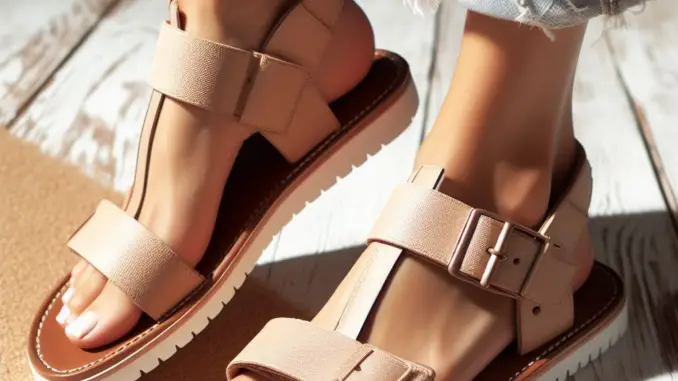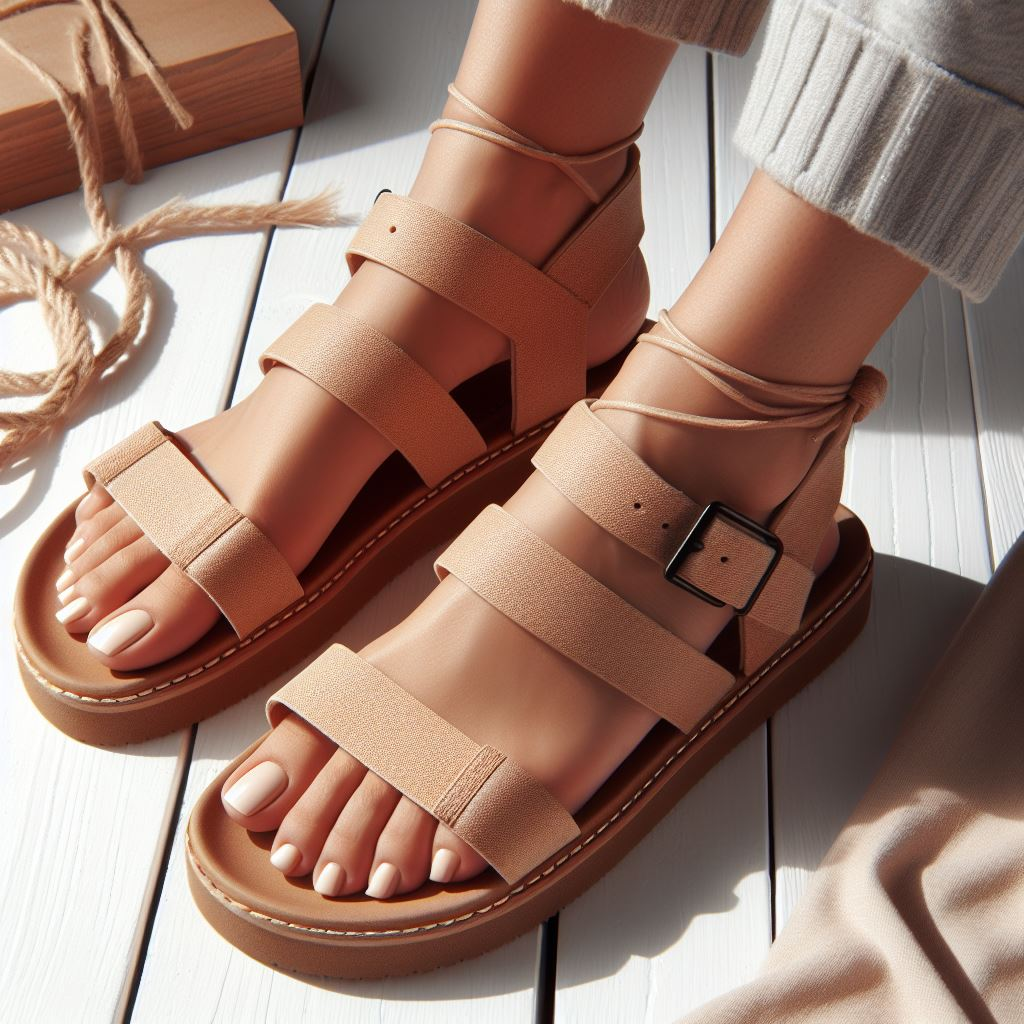
How do you keep the straps up on sandals?
If you’ve ever worn sandals, you’ve likely experienced the annoyance of straps that just won’t stay put. As you walk, the straps slip down your heels or flop around, requiring constant adjusting to keep them in place. It can really put a damper on wearing your favorite summer sandals.
But don’t stash away your sandals just yet! With some handy tricks, you can get your straps to stay firmly in place so you can enjoy carefree wear. Let’s take a look at why straps slip and how to solve it once and for all.
Getting to the Root of the Problem: Why Do Straps Slip Down?

Before diving into solutions, it helps to understand the root causes of why straps lose their grip in the first place. There are a few key culprits to blame:
Incorrect Sizing
Ill-fitting sandals are often the reason behind slipping straps. When sandals are too loose, the straps lack tension to stay secured around your foot. On the flip side, too-tight straps dig into your skin, eventually stretching out and losing their holding power.
The key is to find the Goldilocks “just right” fit – not too loose and not too tight. Straps should feel snug yet comfortable around the contours of your foot. If you’re between sizes, consider sizing down for a more secure fit.
Cheap Materials and Construction
Flimsy sandal materials that lack durability and structure can lead to failing straps. Look for sturdy materials like leather, thick polymers, or durable rubber soles in the construction. Avoid super thin or stretchy straps that will loosen over time and use.
Also inspect craftsmanship. Sandals held together by glue or weak stitching can deteriorate and come apart easier. High quality construction and materials make a huge difference in strap longevity.
Wear and Tear Over Time
General wear and tear over years of use will deteriorate even the best quality sandal straps. As the materials break down from sun exposure, humidity, and abrasion, the grip weakens. Rotate your sandals so you don’t wear the same pair daily, which adds to degradation issues.
Preventative Measures For Reducing Strap Slippage
An ounce of prevention is worth a pound of cure when it comes to sandal straps. Follow these preventative measures from the start to enhance the staying power of your straps:
Opt for Adjustability
Searching for sandals with adjustable straps or buckles allows you to truly customize the fit. After buckling on the sandals, take a few test walks and observe if and where strap slippage occurs. From there, you can tweak and tighten specific areas for your ideal fit.
Some adjust on a sliding scale while others have multiple buckle positions. This versatility keeps tension just right as your feet swell and contract or as the sandals begin stretching with wear.
Choose Security Features like Ankle and Heel Straps
Opt for sandals with extra ankle straps or sturdy heel straps to enhance security in addition to front straps. The ankle and heel straps grip the back of your foot for stabilization as you walk, preventing the common issue of top straps slipping down heels.
These additional contact points on your foot anchor the sandals in securely. Test that any rear straps feel snug yet comfortable before committing to that sandal pair.
Rough Up Leather Bottoms
If rocking leather sandals, the slick finish on the bottom can contribute to slipping issues. Before first wear, take some mid-grit sandpaper to the bottoms to rough them up a bit. This helps create friction between your soles and the footbed leather.
Don’t sand too aggressively to avoid damaging the leather – just a few quick swipes to take the polished finish down slightly goes a long way. This trick can make a remarkable grip difference and is a quick, free fix!
DIY Solutions For Instant Sandal Strap Security
If your straps are already slipping, not to worry – you can implement some easy DIY solutions for an instant fix on the go:
Use Double Sided Tape
A temporary yet effective trick is to place small pieces of heavy duty double sided tape on the underside edges of the loose straps. As you wear the sandals, the tape adheres securely to your foot for an anti-slip effect. Look for thick foam tapes to avoid discomfort.
While not the cutest look if the tape is visible, it gets the utility job done – and nobody has to know your secret! Just be mindful to check the tape’s adhesive status and replace once losing its stick.
Apply Grip Pads
For a slightly more aesthetically pleasing solution, try self-adhesive silicone grip pads. Place a few strategically under straps prone to slipping downward. The pads add just the right amount of friction to keep straps from losing their positioning.
Over time on sandals you wear frequently, the pads may slide around. Check to make sure they remain fully adhered while walking to prevent pressure points.
Use Strap Extenders
If your toe straps are too tight while ankle straps remain loose, handy strap extenders can save the day. These small adjustable pieces attach onto the ends of straps to lengthen them. This allows you to loosen straps putting uncomfortable pressure on toes while still tightening looser top and ankle straps.
Look for universal extenders with varied adjustment holes for versatility or check if your specific brand sells matching extenders. They just slip into place and can make a world of comfort difference!
Long Term Solutions for Keeping Sandal Straps Up
For ongoing sandal strap security, implement these long term solutions into your footwear care regimen:
Condition Leather Straps
Over time, uncared for leather straps dry out and can crack and split from the abrasion of everyday wear. Conditioning keeps leather supple and strong. Every few months, gently rub conditioner into both sides of leather straps.
Avoid over-conditioning which can deteriorate stitching glue. Check that conditioner doesn’t leave behind an overly greasy finish which could create slipping issues on its own.
Reinforce Stitching
Inspect the stitching closely where straps join the sole. Weakened threads from wear can unravel and cause detachment issues. At the first sign of deterioration, reinforce stitching by hand or with a leatherworking awl tool.
If the deterioration has progressed too far for at-home repair, consider taking to a trusted cobbler to stitch the straps back in place securely.
Add Protective Patches
Consider placing small patches of durable material at high abrasion points along straps prone to wear over time. Areas commonly digging into your skin can gradually damage strap integrity.
For leather sandals, adhere suede patches to the undersides for friction. On rubber or polymer straps, self-adhesive thermoplastic patches offer longer term reinforcement in weak spots.
Proactively protecting vulnerable pressure points enhances longevity so you can keep on rockin’ those sandals for seasons to come!
When to Consider Replacing Sandals

No matter how much sandal TLC you give them, there comes a point when keeping straps firmly in place turns into an uphill battle. If you’ve tried the full gamut of stabilizing tricks yet STILL face slipping issues, replacement may be your best course of action for ongoing enjoyment.
Signs that signal it’s time to retire those faithful flip flops include:
- Perished, dried out materials like cracked leather
- Broken hardware that can’t be repaired like detached buckles
- Excessive sole wear
- Thinned out, overstretched straps
- Deteriorated stitching and glue
While it’s tempting to hold onto favorite sandals out of nostalgia or frugality, worn out pairs do your feet and comfort no favors. Not addressing these deterioration issues often results in tendon, arch, or toe injuries from lack of support.
Consider a Replaceable Sandal Brand
If you just can’t part with the style of your well-loved sandals, explore brands offering replacement straps, footbeds, or soles. This allows you to swap out only the damaged elements to mix and match fresh pieces with the retained components still intact.
Some manufacturers sell refurbishment kits for their signature bestselling styles. Search “[your sandal brand/model] refurb kit” to uncover if yours qualifies for easy upgrades.
Find an Identical or Similar Style
Can’t bear to part with that custom woven leather pattern that’s unique to your sandal line? Many brands maintain signature looks year after year or cycle retired styles back in. Search resale sites for NWT (“new with tags”) condition replacements to score the same pair fresh.
If permanently discontinued, look for design doppelgangers from other brands. Examine details like strap placement and decorative elements to match as closely as possible while still new.
While no sandal will ever replace your perfectly molded comfort pair, the above refreshing tricks come close in restoring flip flop happiness without the slip!


Leave a Reply